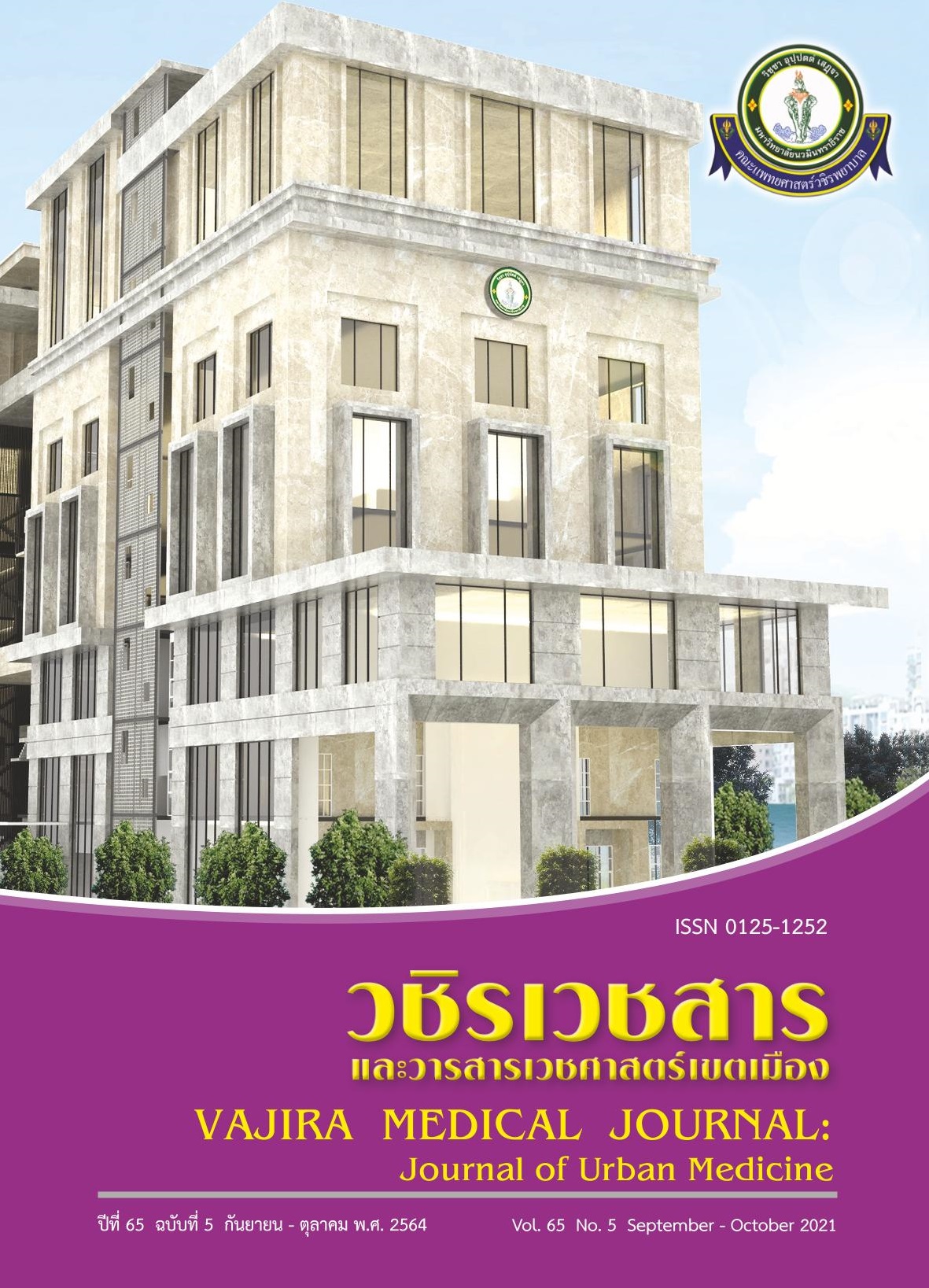Pulse Dose versus Continuous Dose of Calciferol on Vascular Stiffness in Diabetic Kidney Disease: A Randomized Trial
Main Article Content
Abstract
Objective: Vitamin D deficiency is a common condition among chronic kidney disease (CKD) patients. It is associated with cardiovascular mortality. Giving calciferol to CKD patients could help reduce vascular stiffness and decrease the risks of coronary artery disease and mortality. The current recommendation for treating vitamin D deficiency in CKD patients is using the same treatment strategies for the general population. However, there is no recommendation on the exact dose and duration. The purpose of this trial is to compare the effects of pulse dose versus continuous dose of calciferol on vascular stiffness in diabetic kidney patients.
Methods: 31 patients with type 2 diabetes mellitus (T2DM), eGFR 15-59 mL/min/1.73 m2, and 25(OH) D level < 30 ng/mL, were enrolled in this randomized, open-label trial to receive either pulse dose (200,000 IU at the 0th and 8th weeks) or continuous dose (40,000 IU weekly for 8 weeks then 20,000 IU weekly for 2 weeks) of calciferol. The primary outcome was the vascular stiffness measured by the changes in carotid-femoral pulse wave velocity (cfPWV) at 10th week.
Results: The mean 25(OH)D level at the baseline was 18.7 ng/mL in the pulse dose versus 19.9 ng/mL in the continuous dose. In the pulse dose, 10 patients (66.7%) achieved optimal vitamin D level while 6 patients (40%) did in the continuous dose. The mean change of cfPWV between the two groups, which was -0.5 (95%CI -3.15 to 2.15) (p=0.703), was not statistically significant. No adverse effect was reported.
Conclusion: 10 weeks of calciferol given to CKD patients with T2DM and 25(OH)D < 30 ng/mL could achieve a higher reduction of Cardio-ankle vascular index in the pulse dose group than in the continuous dose group. Despite the lack of statistically significant change in Carotid-femoral pulse wave velocity (cfPWV), there seemed to be a higher cfPWV reduction in the pulse dose, with the achievement of 25(OH)D level.
Downloads
Article Details
References
LaClair RE, Hellman RN, Karp SL, Kraus M, Ofner S, Li Q, et al. Prevalence of calcidiol deficiency in CKD: a cross-sectional study across latitudes in the United States. Am J Kidney Dis 2005;45(6):1026-33.
Flammer AJ, Anderson T, Celermajer DS, Creager MA, Deanfield J, Ganz P, et al. The assessment of endothelial function: from research into clinical practice. Circulation 2012;126(6):753-67.
Munakata M. Brachial-ankle pulse wave velocity in the measurement of arterial stiffness: recent evidence and clinical applications. Curr Hypertens Rev 2014;10(1):49-57.
Mancia G, Fagard R, Narkiewicz K, Redon J, Zanchetti A, Bohm M, et al. 2013 ESH/ESC Guidelines for the management of arterial hypertension: the Task Force for the management of arterial hypertension of the European Society of Hypertension (ESH) and of the European Society of Cardiology (ESC). J Hypertens 2013;31(7):1281-357.
Vlachopoulos C, Aznaouridis K, Stefanadis C. Prediction of cardiovascular events and all-cause mortality with arterial stiffness: a systematic review and meta-analysis. J Am Coll Cardiol 2010;55(13):1318-27.
Saiki A, Sato Y, Watanabe R, Watanabe Y, Imamura H, Yamaguchi T, et al. The Role of a Novel Arterial Stiffness Parameter, Cardio-Ankle Vascular Index (CAVI), as a Surrogate Marker for Cardiovascular Diseases. J Atheroscler Thromb 2016;23(2):155-68.
Chitalia N, Recio-Mayoral A, Kaski JC, Banerjee D. Vitamin D deficiency and endothelial dysfunction in non-dialysis chronic kidney disease patients. Atherosclerosis 2012;220(1):265-8.
Kumar V, Yadav AK, Lal A, Kumar V, Singhal M, Billot L, et al. A Randomized Trial of Vitamin D Supplementation on Vascular Function in CKD. J Am Soc Nephrol 2017;28(10):3100-8.
Ketteler M, Block GA, Evenepoel P, Fukagawa M, Herzog CA, McCann L, et al. Diagnosis, Evaluation, Prevention, and Treatment of Chronic Kidney Disease-Mineral and Bone Disorder: Synopsis of the Kidney Disease: Improving Global Outcomes 2017 Clinical Practice Guideline Update. Ann Intern Med 2018;168(6):422-30.
Holick MF, Binkley NC, Bischoff-Ferrari HA, Gordon CM, Hanley DA, Heaney RP, et al. Evaluation, treatment, and prevention of vitamin D deficiency: an Endocrine Society clinical practice guideline. J Clin Endocrinol Metab 2011;96(7):1911-30.
Shieh A, Chun RF, Ma C, Witzel S, Meyer B, Rafison B, et al. Effects of High-Dose Vitamin D2 Versus D3 on Total and Free 25-Hydroxyvitamin D and Markers of Calcium Balance. J Clin Endocrinol Metab 2016;101(8):3070-8.
Millasseau SC, Stewart AD, Patel SJ, Redwood SR, Chowienczyk PJ. Evaluation of carotid-femoral pulse wave velocity: influence of timing algorithm and heart rate. Hypertension 2005;45(2):222-6.
Sugawara J, Hayashi K, Yokoi T, Tanaka H. Age-associated elongation of the ascending aorta in adults. JACC Cardiovasc Imaging 2008;1(6):739-48.
Yamashina A, Tomiyama H, Takeda K, Tsuda H, Arai T, Hirose K, et al. Validity, reproducibility, and clinical significance of noninvasive brachialankle pulse wave velocity measurement. Hypertens Res 2002;25(3):359-64.
Levin A, Tang M, Perry T, Zalunardo N, Beaulieu M, Dubland JA, et al. Randomized Controlled Trial for the Effect of Vitamin D Supplementation on Vascular Stiffness in CKD. Clin J Am Soc Nephrol 2017;12(9):1447-60.
Mann MC, Hobbs AJ, Hemmelgarn BR, Roberts DJ, Ahmed SB, Rabi DM. Effect of oral vitamin D analogs on mortality and cardiovascular outcomes among adults with chronic kidney disease: a meta-analysis. Clin Kidney J 2015;8(1):41-8.


